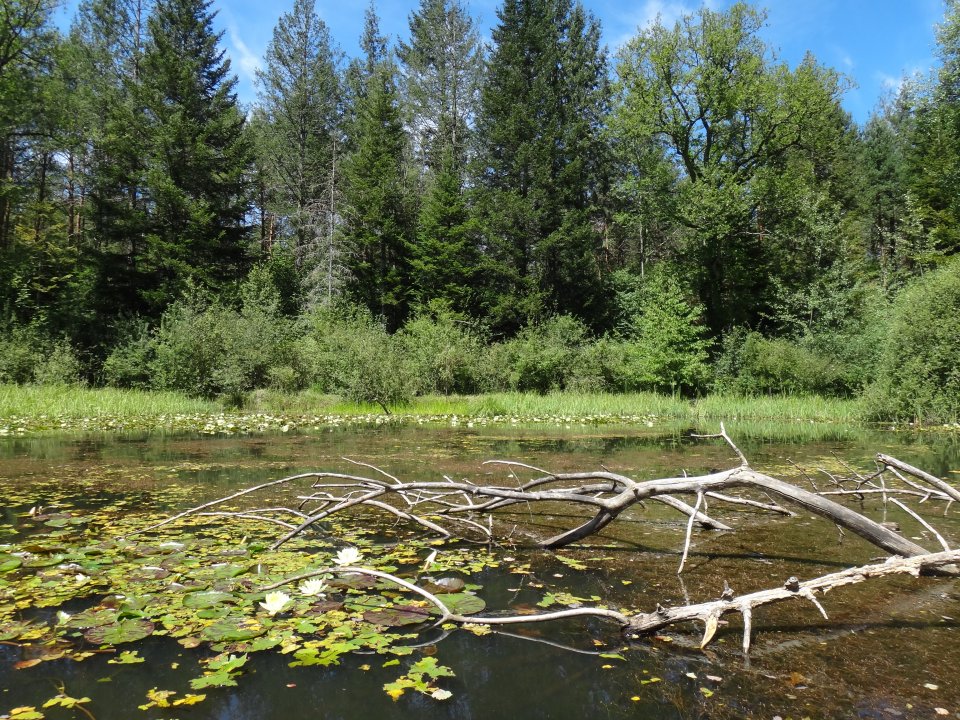
Bois de Jussy is located about 15 km from the city of Geneva (600' 000 inhabitants) in a mostly wooded setting surrounded by cultivated land. The delineation of the pondscape is based on the limits of the forest, as well as the fact that it represents a coherent entity in term of nature management.
Before 1960 there were no ponds in Bois de Jussy. Today, in an area of 6 km2 Bois de jussy contains about 70 ponds within a range of differents surfaces and depths as well as different hydroperiod.
The density of large to medium ponds reaches 4/km2, 33/km2 if the smallest pools are included. That is exceptional compared to the average in Switzerland of 1 pond/km2 and compared to the minimum number required for amphibians (4) and dragonflies (5 to 10).
A large part is accessible to the public (85%).
The pondscape is owned and managed by the Geneva authority in charge of Nature and Agriculture and ProNatura, the oldest organisation for nature conservation in Switzerland which is in charge of some Nature reserves.
The management includes conservation and regeneration of existing wetlands, as well as the creation of new ponds and the maintenance of their quality through management actions. These are mainly conducted by the regional authorities (Cantons) and implemented by private consultancies, with subsidies coming from the government (65% of management cost is linked to the national inventories of natural sites). This policy framework allows for effective and successful protection and promotion of pond biodiversity. The good collaboration and synergy between the Canton, the NGOs and environmental consultancies is also a key factor in the fruitful and effective implementation of the NBS.
Bois de Jussy is managed to maximise the biodiversity, and to welcome the public for walks, jogging and biking to relax, cool off, reconnect with nature by observing ponds.
Bois de Jussy is hotspot for biodiversity, recognized as an amphibian breeding site of national importance (4 sites), and hosting a wetland of national importance (based on the flora community) (1 site). It is also the site of an experimental species reintroduction program (European pond Turtle, Emys orbicularis) (4 sites). The local population and visitors expressed the added value of this pondscape to their well-being and recognized its ecological quality.
- Developing climate change adaptation; improving risk management and resilience
- Reducing temperature at meso or micro scale
- Improve connectivity and functionality of green and blue infrastructures
- Increase Biodiversity
- Increase accessibility to green open spaces
- Increase well-being
The keys of success rely to :
- The implementation of several protection statuts in the pondscape (covering 60.5% of its surface), together with a regulation of the flow of visitors (car park on the periphery, hiking trails, observatories), allowed to maintain a low anthropic pressure and enabled a full development of the biodiversity in all ponds.
- The creation of an heterogeneous set of ponds that vary in their morphometry, age or water chemistry has proved to be highly beneficial in increasing the capacity of the pondscape to host flora and fauna.
- The implementation of various management measures, such as the identification and removal of dispersal barriers for amphibians (creation of passages under the road, installation of temporary barriers to move individuals daily during the migration period), the combination of forest environement and ponds (favorable for aquatic and terrestrial biodiversity including amphibians, dragonflies, aquatic plants, larges and small mammals, bats and birds) and the monitoring and elimination of invasive species when required.
The creation of a dense network of ponds together with several protection statutes and various management measures of the pondscape can be expensive but proved to be the key of the successful development of biodiversity and could be implemented elsewhere in a slighter form. The local population and the visitors expressed their satisfaction and the added value of this pondscape to their well-being.
Further information
Boissezon, A., Sordet, A., Fahy, J., Demierre, E., Hornung, J., & Oertli, B. (2024). Pondscape: Bois de Jussy. (English version) (Version V1). Zenodo. https://doi.org/10.5281/zenodo.10939753
Boissezon, A., Sordet, A., Fahy, J., Demierre, E., Hornung, J., & Oertli, B. (2024). Pondscape: Bois de Jussy. (French version) (Version V1). Zenodo. https://doi.org/10.5281/zenodo.10947288
- 3. Good Health and Well-being
- 6. Clean Water and Sanitation
- 14. Life Below Water
- 15. Life On Land
